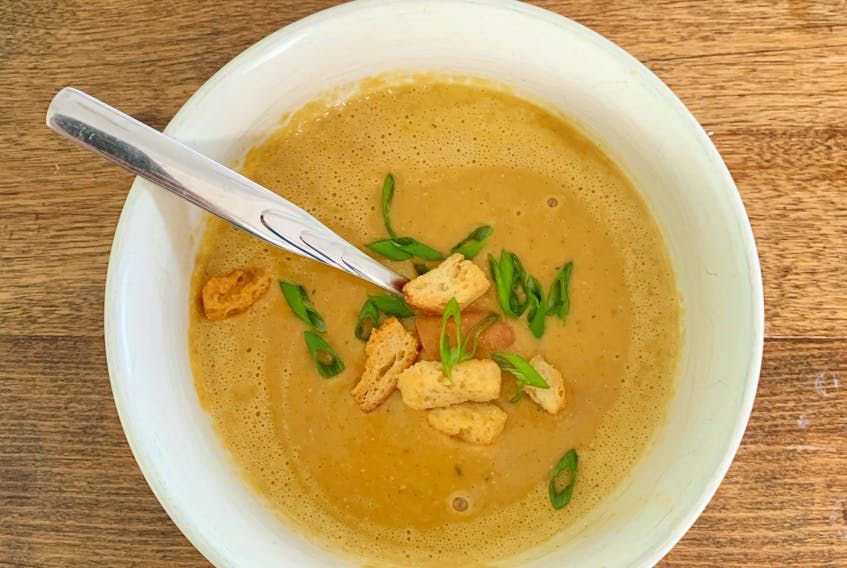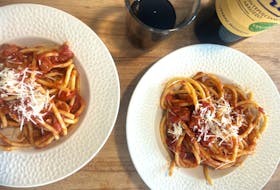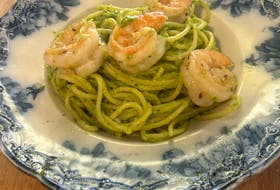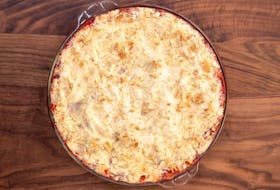According to Google Trends, one of the most-searched food terms in Canada in 2020 was butternut squash recipes.
And the Canadians most interested were Newfoundlanders, who began looking for recipes last January and started trending again in August. The search was also hot for New Brunswickers - they followed closely behind in terms of searches - while Nova Scotians also wanted to know what to do with butternut squash.
Just what is the appeal?
According to Jackson McLean, manager of The Seed Company in St. John’s, N.L., butternut squash is one of the tastiest vegetables to grow because of its unique buttery taste.
Given the general increase of interest in gardening during the pandemic, Jackson says he’s not surprised to hear that butternut squash recipes were a top trend on Google. Although butternut squash aren’t as commonly grown in Newfoundland, and weren't among their top seed sellers last year, they do grow just as well in the province's climate as any other squash, pumpkin or zucchini.
Butternut squash, says Jackson, is moderately easy to grow, but should be started indoors as they do take 100 to 110 days to mature, longer than the average Newfoundland growing season. They also require a decent amount of fertilizer to produce a good yield.
Revival in Popularity
Ann Marion Willis, an in-store registered dietitian with Atlantic Superstores in Sydney, Glace Bay, and North Sydney, says the butternut squash has definitely had a bit of a revival because it’s readily available in Canada, easy to grow for new gardeners, hardy enough to stand being stored at home for a few weeks, and is incredibly versatile for even the most selective of eaters.
“As you can purchase butternut squash whole, prepared fresh or frozen in cubes or spirals and even canned purees, it’s convenient to prepare whether you’re highly skilled in the kitchen or not,” says Willis.
Felicia Newell, a registered dietitian and nutritionist with FN Health located in St. John’s, N.L., believes the popularity of the butternut squash began in Newfoundland prior to COVID-19. It's been popular for a while in certain groups of individuals, she says, such as those moving towards or following a more plant-based diet, or those who like to buy seasonal vegetable and buy it when it’s locally available, or those who just have a varied diet in general.
A lot of the squash’s popularity has to do with the diet culture as its health benefits are promoted along with the fact that it is low calorie, low carb, yet filling because it is high in fibre, says Newell. As well, those who consume more of a more plant-based diet tend to be more open to trying new foods, she says.
Some Newfoundlanders have a more limited variety in their diet, Newell said, and even when they have cooked dinners with vegetables, the more commonly-consumed ones include cabbage, turnip or rutabaga, parsnip, carrots, and potatoes.
"In my experience, those who are tied to the ‘traditional Newfoundland diet’ tend to not like to try new foods so it would be less popular with these groups," she says.
Health Benefits
Besides being easy to grow and readily available, butternut squash is nutritious. It is high in health-supporting nutrients such as vitamin A and potassium, and it’s a good source of fibre, vitamin C, calcium and is also low in carbohydrates and calories, says Newell.
Vitamin A is essential for regulating cell growth, eye health, bone health, and immune function, while vitamin C, a water-soluble nutrient needed for immune function, collagen synthesis, wound healing, and tissue repair, explains Newell.
"One cup of cooked butternut squash has only 83 calories and provides seven grams of filling fibre," explains Newell.
Many studies have found that a higher dietary fibre intake promotes weight loss and reduces body fat. Keep in mind, she says, you can have a high fibre intake and still consume a moderate amount of carbs and still be healthy and reduce body fat.
“Butternut squash is technically a fruit,” says Newell. “But because of its savoury profile, it is used mostly in cooking as a vegetable and referred to as a vegetable.”
What makes this squash a popular family favourite, says Willis, is its mild, sweet flavour and it’s smooth, creamy flesh. This makes it perfect for soups, sauces, roasted vegetable dishes, and more.
“It’s very versatile and you can roast it, grill it, steam it, add it to soups, pies, and more,” says Newell.
Additionally, you can roast the seeds, seasoning them with some spices and herbs, and toss them on your favourite salad or into some trail mix, she adds.

How to prepare
The easiest way to peel butternut squash, says Willis, is to put it in the microwave. Poke the skin all over, about 10 to 15 times, to allow steam to release. Then, place it in a baking dish or deep plate, and cook on high for five to seven minutes, depending on size.
Then, slice it in half if you’ll be baking it; score and scoop if you plan to roast or puree. Remove the seeds and roast for a snack, or dry and plant in your garden come springtime, explains Willis.
Alternatively, Newell says you can just use a paring knife or vegetable peeler and peel butternut squash in the same way you would a turnip or potato. Then, use your hands or a spoon to scrape out all the seeds. You can dice it up into cubes and roast in the oven with oil and other seasonings. It can be used as a side dish, in tacos, quesadillas, burritos, on a salad, and more.
Roasting squash brings out the flavour, so you would likely want to do this before using it in a soup as well, says Newell. Roast the halves instead of it cutting into cubes, as if you were doing a stuffed squash recipe. It does take longer to cook this way, she adds.
“I love roasting mine with some maple syrup, smoked paprika, salt and pepper, then adding it to a dish of roasted Brussel sprouts, sweet, dried cranberries, crisp bacon, and diced baked chicken breast,” says Willis.
You can also cook a butternut squash without peeling it, says Newell. Roast it whole after poking holes in it, then just peel and scoop out the flesh when it's done. This is great if you’re making a mash or a soup with it. Keep in mind this takes a while to cook, about 60 to 80 minutes at 425 degrees F. You can also cut it in half and scoop out the seeds and then cook the halves without peeling, reducing the cooking time to about 45 minutes at 375 degrees F, explains Newell.
Or you can also cook butternut squash in a slow cooker or instant pot – there are many ways, says Newell.
Spiralized, it makes great noodles, adds Willis, or it can be used in Thai-inspired dishes with a rich peanut sauce on top.
"The most epic mac and cheese I’ve ever eaten was made with butternut squash in the sauce," says Willis. "And nothing beats replacing the white potatoes on my lentil shepherd’s pie with a fifty-fifty mix of sweet potato and butternut squash – the perfect balance of sweet, rich, and fluffy."
Store cooked squash in an airtight container in the fridge, or in a zip-top bag or other airtight container in the freezer, says Newell. If you want to freeze cooked butternut squash cubes, place them on a parchment paper-lined baking sheet and freeze until solid before moving them to a freezer bag or container. This will prevent them from sticking together, she says.
Newell offers a final word of caution: any time we see something labelled as a ‘superfood’, popularity tends to increase. She says, however, that there’s really no one food that can increase or reduce health. "We need to look at the balance of the diet as a whole as well as our relationship with food, instead of focusing on one food or food group as the be all end all to health," she says, adding that she encourages people to try adding butternut squash to your overall healthy food plan.
See more recipes at SaltWire.com
Learn more at
https://www.felicianewellhealth.com/
https://www.facebook.com/atlanticss.dietitian.annmarion
Easy Peasy (Veggie-Heavy) Mac & Cheesy
This is a great main dish served with a salad or steamed/roasted veggies, or as a side with your BBQ protein & fresh garden saladm says Willis.

Ingredients:
- 1 bag frozen butternut squash or ~1.5lb fresh squash - about 3 cups mashed.
- 8oz/2 cups dry whole grain pasta (GF tip at the bottom)
- 3 tsp vegetable or olive oil (plus additional for baking squash)
- 2 tbsp all-purpose flour (or GF all-purpose)
- 1/4 tsp pepper
- 1/2 tsp basil
- 1 tsp paprika
- 1 cup milk (or milk alternative)
- 2 cups shredded cheese (see tip below!)
- 1/4 cup shredded cheese, for sprinkling on top
- Sprinkle of dry parsley for top
Instructions:
1. Preheat oven to 375 F
2. Line a baking sheet with parchment paper or a silicone baking sheet.
3. To bake fresh squash - cut in half, brush lightly with oil, place on baking sheet cut side down. Bake until fork-tender, about 30-45 minutes depending on size. Allow to cool before discarding seeds and skin, scoop out flesh, mash, and set aside. Alternatively, pierce skin all over and microwave until tender.
For frozen squash: toss cubes in oil, spread evenly on pan, bake until tender. Mash and set aside.
4. Cook pasta according to the box directions for al dente texture while the squash bakes. Drain and set aside.
5. Heat vegetable oil over medium heat in a medium pot. Whisk in flour, pepper, basil, and paprika and stir for one or two minutes. Add milk slowly while stirring to remove lumps. Cook, stirring consistently until thick and bubbly, about five minutes.
6. Stir in mashed squash and two cups of shredded cheese, stir until melted and well combined. Add cooked pasta, gently combine and then remove from heat.
7. Oil or spray a 9x13 dish, add pasta mixture. Gently spread out evenly, sprinkle remaining shredded cheese and parsley on top.
8. Bake until golden brown, about 15-20 minutes. Enjoy!
Alternatives:
Gluten-Free: We prefer chickpea/legume-based pasta as it holds up well for leftovers, but whatever GF pasta you choose, be careful not to overcook it when boiling! If anything, undercook slightly, as it will continue cooking while in the oven.
Lactose-free: choose LF milk or your favourite milk alternative, and LF block cheese. "I have not tried this with dairy-free cheese," Willis says.
Pre-shredded vs block cheese: "I recommend shredding your own cheese if possible, it will melt a little smoother but it will work either way," says Willis. "I also recommend choosing a mixture of at least two types of cheese (ie. Monterey Jack and medium cheddar) but again, choose what you have on hand or your family's favourite."
Butternut Squash & Carrot Soup
Source: Pc.ca
Ingredients:
- Bag of frozen butternut squash
- 3 chopped carrots
- 1-2 tbsp olive oil
- 1 cup dry red lentils
- 1 can full-fat coconut milk
- 2 garlic cloves
- Sprinkle of ginger, minced onion, sage and paprika
- 4 cups broth
- 2 cups water
Instructions:
- Add your veggies and olive oil, cook until beginning to soften while occasionally stirring, for 5-10 minutes.
- Add garlic, cook for 1-2 minutes until soft.
- Add your other ingredients, bring to a boil, allow to simmer until lentils are cooked through and liquid begins to reduce, 10-15 minutes.
- Allow to cool for a few minutes, then carefully purée using an immersion blender, food processor or blender (may need to do small batches).
- Serve with green onion and croutons!
Plant Power Shepherd’s Pie
Source: pc.ca
Swapping out some of the ground beef for lentils in shepherd’s pie is a smart way to save money and sneak more fibre onto your plate. Sweet potatoes and butternut squash make a lower-calorie and more nutrient-dense alternative to white potatoes in the mash.
Ingredients:
Base:
- 3/4 cup (175 mL) dry PC Blue Menu Green Lentils, rinsed
- 2 tbsp (25 mL) PC New World EVOO Extra Virgin Olive Oil
- 1 onion, finely chopped
- 1 large carrot, finely chopped
- 1 stalk celery, finely chopped
- 6 cloves garlic, minced
- 1 tsp (5 mL) salt
- 1/2 tsp (2 mL) each freshly ground black pepper, dried thyme and sweet paprika
- 250 g PC Free From Lean Ground Beef
- 1 tbsp (15 mL) all-purpose flour
- 1 tbsp (15 mL) tomato paste
- 1 1/2 cups (375 mL) PC Blue Menu Beef Broth
- 1 tbsp (15 mL) Worcestershire sauce
- 3/4 cup (175 mL) frozen PC Petits Pois Small Sweet Peas
Topping:
- 2 sweet potatoes, peeled and chopped (about 3 cups)
- 2 cups (500 mL) Butternut squash, diced (fresh or frozen)
- 1/4 cup (50 mL) milk
- 2 tbsp (25 mL) PC Unsalted Country Churned Butter
- 1/2 tsp (2 mL) each salt and freshly ground black pepper
Instructions:
1. Preheat oven to 400°F (200°C). Place lentils in small saucepan; add enough cold water to cover by two inches (5 cms). Bring to a boil; reduce heat to a simmer and cook uncovered until tender, 15 to 20 minutes. Drain.
2. Meanwhile, heat oil in large saucepan over medium-high heat. Add onion, carrot, celery and garlic; cook, stirring often, until softened, about five minutes. Add salt, pepper, thyme and paprika; cook, stirring, one minute.
3. Add beef; cook, breaking up with spoon, until browned, about five minutes. Stir in flour and tomato paste; cook, stirring, for one minute. Add broth, Worcestershire sauce and lentils; bring to a simmer. Add frozen peas; reduce heat to medium-low and cook two to three minutes.
4. Meanwhile, prepare topping: Fill separate large saucepan with water; bring to a boil. Add sweet potatoes; reduce heat to a simmer and cook five minutes. Add butternut squash; return to a simmer and cook until vegetables are tender, five to seven minutes. Drain; transfer to large bowl. Add milk, butter, salt and pepper; mash with potato masher until smooth.
5. Transfer beef mixture to 8-inch (2 L) square glass baking dish. Top with sweet potato mixture, spreading evenly. Bake until filling is bubbly and topping is lightly browned, 25 to 30 minutes. Let stand five minutes before serving.
Makes 8 servings.









